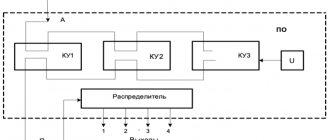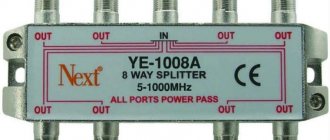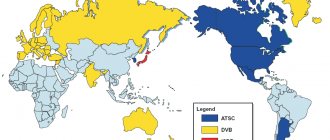What is NTSC?
So, many American video recording media are in NTSC format. What it is? Today it is the color encoding system used by DVD players. Until recently, it was used by broadcast television in North America, Japan and much of South America.
As color televisions began to replace black-and-white televisions, developers began using several different methods to encode color for broadcast. However, these methods conflicted with each other and with old black-and-white televisions, which could not interpret the color signals transmitted to them. In 1953, the US National Television System Committee adopted the NTSC standard, which was developed and implemented as a single standard. From that moment on, it could be used throughout the country, as it became compatible with a large number of different TVs. Nowadays you can still find NTSC. What does it mean? Even though modern TVs no longer use this format, they can still receive and recognize it.
What channels are available for viewing?
What will those who switch to a new type of television broadcast watch? How many and what channels? Some people are familiar with these channels, while others want an explanation. We remind you that these are 20 free Russian channels, grouped into two digital packages RTRS-1 and RTRS-2, which are transmitted in the UHF range.
The availability of each digital package in each region should be checked on the official website of digital television in the Russian Federation. But in general, RTRS-1 and RTRS-2 are broadcast almost everywhere, are free and are not encrypted.
The first multiplex included the flagships of all-Russian television broadcasting - such channels as:
- Channel One, Russia 1, OTR, NTV, news channel Russia 24, sports channel Match TV, Channel Five, Russia “Culture”, children’s entertainment channel “Carousel”, as well as the government federal channel TVC.
The second multiplex combines channels:
- Ren TV, Spas, Zvezda, STS, Mir, Domashny, TNT, TV channel TV 3, Friday and Muz TV.
Such fullness of television multiplexes is determined by the relevant Decrees of the President of the Russian Federation and from time to time it is adjusted taking into account the requests of the television audience.
What is PAL format?
Before you decide which is better - PAL or NTSC, you need to understand how they differ from each other.
The PAL format is a color encoding system used by DVD players and broadcast television in Europe, much of Asia and Oceania, Africa and parts of South America.
Phase Alternating Line or PAL formatting, along with the SECAM standard (previously used in Russia and the CIS, the image in this method is translated as sequential color with memory), was developed in the late 1950s to circumvent certain shortcomings of the NTSC system.
Because NTSC encodes color, it means the signal can lose clarity in poor conditions, so early systems built on this format were vulnerable to bad weather, large buildings, and several other factors. To solve this problem, the PAL video format was created. It works as follows: during broadcast, it changes every second line in the signal, effectively eliminating errors.
Unlike NTSC, PAL is still often used for over-the-air broadcasting in the regions in which it was adopted.
VIDEO-SAM.RU
Television or, more precisely, television broadcasting according to the type of signal transmission can be divided into three types: Terrestrial television (terrestrial); Cable TV (cable). Satellite television (satellite); Additionally, broadcasting for mobile and portable devices is actively developing. Some cellular operators are already starting such transmissions in GPRS networks. One of the most important characteristics of television broadcasting is the bandwidth of the communication channel. Cable television channels have the highest capacity , which provide a significant degree of protection from interference to the transmitted signal. The consequence of this is a wider range of broadcast frequencies.
It is cable television systems, which are found today in all major cities, that offer the most affordable and high-quality television broadcasting services, as well as additionally high-speed Internet access. But for the majority of the population of our country, terrestrial television broadcasting . It appeared much earlier than cable and spread everywhere. Television transmitters installed on towers emit television signals that are propagated using radio waves. The waves are received by individual or collective television antennas and are sent to our televisions.
The main problem of terrestrial terrestrial television is its small coverage area. It directly depends on the height of the television tower and is limited by the line-of-sight zone between the antennas of the transmitter and receiver of the signal. If the TV receiver is located outside such a zone, the signal level drops sharply and viewing programs is almost impossible. That is why repeater towers are installed throughout the country at certain distances, which transmit the signal along the relay. Another disadvantage of terrestrial television broadcasting is that radio waves are much more susceptible to interference. To eliminate interference, special forms of coding are used, which require additional frequencies, i.e. wider range.
Nowadays, satellite television is becoming increasingly widespread. This is also on-air television broadcasting using radio waves, but artificial satellites located in geostationary orbit are used as a repeater (transmitting antenna).
Satellite television can provide quality Sinhala in areas inaccessible to conventional terrestrial television broadcasting. In addition, it is famous for its large selection of programs and the ability to provide various additional services. To receive a signal from a satellite, in addition to the TV, you need special equipment: a special antenna, which is called a satellite dish, a converter and a receiver (signal receiver), and, of course, cables and mounting brackets.
The satellite is called geostationary because it is constantly located at one point in relation to a given locality. Knowing the location of the satellite relative to your city, a satellite dish is pointed at it, and it constantly remains in this position. To install satellite television, a specialist is usually invited, but, in principle, installation and adjustment of equipment can be done by a technically competent person. Having installed equipment for satellite television broadcasting, you can select various program packages from Russian and foreign satellites (the most famous NTV+, Tricolor), receiving high quality picture and sound. In addition, satellite broadcasting offers multi-channel multiplexing (transmission of several television and radio channels on one frequency band, teletext, subtitles, TV guide), 3D television, video on demand, stereo sound or surround sound, choice of broadcast language, satellite Internet, etc. Disadvantage is the sensitivity of radio waves to external conditions, for example, during a thunderstorm, significant interference is possible, including interruption of broadcasting. Analogue television standards: NTSC, PAL, SECAM Digital television systems DVB-T - terrestrial digital television standard
PAL or NTSC: which is better to use?
Many video editing programs, such as VideoStudio, allow you to choose what format to save your work in when burning to DVD.
Which format you should use mainly depends on your location. If you are creating videos that will be displayed around the world, NTSC by choice is safer and more comfortable. Most DVD players and other PAL-based devices can play NTSC video, but NTSC-based players usually do not support PAL.
Why are these formats still used?
The basic answer is that they are not today what they were originally created to be. It is clear that the technical problems that these coding systems were created to solve in the 1950s do not apply to the modern world. However, DVDs are still labeled as supporting NTSC or PAL (see above for which one to buy and why), and the timings, resolutions, and refresh rates set in these systems are still used in modern TVs and monitors.
The main reason for this is the regionalization of content. The use of different video formats acts as a layer of physical protection to strengthen national copyright laws, and prevent the distribution of films and television programs in different countries without permission. In fact, this is the use of formats as a legal method of copyright protection. This phenomenon is so common that distribution regions for video games and other interactive electronic media are often referred to as NTSC and PAL regions, although such software works fine on any type of display.
NTSC or PAL for digital TV
After the 90s, color transfer systems were used:
- in cable, satellite and terrestrial television;
- to implement recordings on magnetic tapes;
Over time, data carriers were completely transformed, magnetic tapes were relegated to the shelf of “obsolete technologies”, where analog TV will soon be. After all, ATV is already being replaced by digital and interactive television on all fronts.
The digital era has come along with new standards. Now the picture in MPEG-4 is supplied separately from the sound. The use of PAL and NTSC standards is no longer necessary.
Essentially, the question of NTSC or PAL for digital TV is not posed correctly. The DVB-T/T2 tuner is responsible for digital playback. Analog signals are implemented by tuners that work with PAL, SECAM and NTSC. A modern TV may have several tuners. If you display analog and digital channels together on your TV, it is recommended to set the PAL/SECAM system for Russia.
Again, if you need to rewrite a movie on a laptop, converting it from digital format to magnetic tape for later viewing via TV / Monitor + VCR, then you may encounter these standards.
PAL, NTSC formats: what is the difference from the technical side?
Televisions display their images line by line and create the illusion of movement by displaying them slightly altered, many times per second. The broadcast signal for black and white television simply indicated the brightness level at each point along a line, so each frame was simply a signal with brightness information for each line.
Initially, televisions displayed 30 frames per second (FPS). However, when color was added to widescreen broadcasts, black-and-white TVs could not distinguish color information from luminance information, so they attempted to display the color signal as part of the picture. As a result, it became meaningless, and the need arose to introduce a new TV standard.
To display color without this problem, the broadcast needed to add a second chrominance signal between the luminance signal fluctuations, which would become ignored by black-and-white TVs, and color devices would look for it and display it using an adapter called a Colorplexer.
Because this extra signal was added between each frame update, it increased the amount of time it took for them to change, and the actual FPS on the display was reduced. Therefore, NTSC TV plays 29.97 frames per second instead of 30.
In turn, a PAL signal uses 625 lines, of which 576 (known as a 576i signal) appear as visible lines on the TV, while a formatted NTSC signal uses 525 lines, of which 480 appear visible (480i). In PAL video, every second line has a phase change in the color signal, which causes them to equalize the frequency between the lines.
Digital television formats
DVB is an acronym for the Digital Video Broadcasting Project, founded in 1993. Currently, this large-scale open project brings together about 300 organizations from 35 countries. The basis for the work of the DVB consortium was a shift towards technical requirements in the development priorities of systems for the delivery of digital information. The end result of the DVB project was a family of new communication standards established for video broadcasting:
- satellite – DVB-S and DVB-S2,
- cable – DVB-C,
- terrestrial DVB-T and DVB-T2.
Terrestrial digital television is gradually replacing analogue broadcasting. This process has already been implemented in many European countries, where the digitization of terrestrial TV has already been completed and analogue broadcasting has been switched off.
What are digital TV multiplexes?
Multiplex DVB-T2 or digital multiplex (from English multiplex) is a package of television channels, radio stations and additional services. Simultaneously broadcast to the recipient in digital (multiplexed) form, on one frequency channel. In other words, it is a combined coded data stream consisting of at least two data streams or more. The multiplex may include information about radio, television, conditional access and additional services programs broadcast on a specific TV channel.
On the territory of the Russian Federation, 20 digital TV channels are currently available for free reception, combined into two multiplexes RTRS-1 and RTRS-2.
What does it mean?
In terms of effect, this means that signal corruption appears as a saturation (color level) error rather than a tint (color tone) error, as it would in NTSC video. This resulted in a more highly accurate picture of the original image. However, the PAL signal loses some vertical color resolution, making colors at line junctions appear a bit washed out, although this effect is not visible to the naked human eye. On modern DVDs, the signal is no longer encoded based on connecting lines, so there are no frequency or phase differences between the two formats.
The only real difference is the resolution and frame rate at which the video is played.
PAL and NTSC on HDTVs
Television has a broad analogue system, so while digital signals and high definition (HD) are becoming a universal standard, variations remain. The primary visual difference between NTSC and PAL systems for HDTV is the refresh rate. NTSC refreshes the screen 30 times per second, while PAL systems refresh the screen 25 frames per second. For some types of content, especially high-resolution images (such as those generated by 3D animation), HDTVs using the PAL system may exhibit a slight tendency to "flicker". However, the picture quality is NTSC and most people won't notice any problems.
On a DVD signal, the signal is not encoded based on the carrier wave, so there are no frequency or phase differences between the two formats. The only real difference is the resolution and frame rate (25 or 30) at which the video is played.










